Trying to combine old finishes with new flooring? I’m sharing two magic questions that will make every decorating or design decision better.
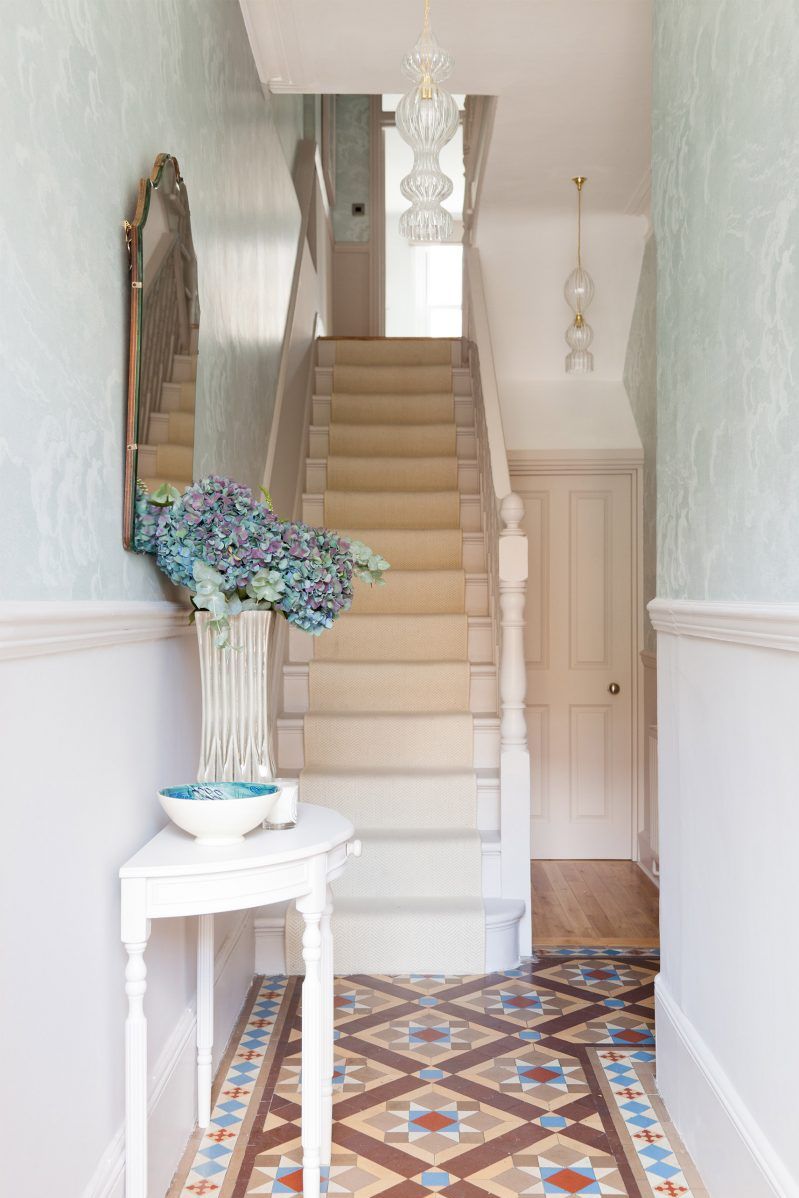
House Beautiful | Read more: Encaustic Tile Trend Post
I received so many questions about flooring from my last post; Are Hardwood Floors a Pattern, it’s clear that this topic needs a follow up post.
Instead of answering individual questions, I’m going to introduce you to two questions that everyone should ask whenever they are installing something new with old.
Every question I received about flooring was about what to do in an existing house.
What’s the best way to combine old with new?
When you build a new house, it’s pretty straightforward. Choose a classic and timeless hardwood (or wood look floor) and install it throughout (except bathrooms or maybe the mudroom). The end.
But renovations and mixing old with new? That’s when it gets complicated.
Two magic phrases every decorator should know
The two most important questions to ask yourself BEFORE you make any decisions about what to do with existing flooring in your house are these:
Important Question #1:
Will my new finishes look like they were all installed at the SAME time?
You don’t even have to have a creative eye to be able to answer this question.
Whenever you are about to make a decision about mixing something NEW in an old and dated room, for example you are ONLY replacing the flooring in your bathroom, or ONLY the backsplash in your dated kitchen, ask yourself this question.
If the answer is NO, then whatever new and trendy tile or countertop you are considering will NOT WORK.
It doesn’t matter if you love it. It doesn’t matter if it matches colour wise. If it looks like a different trend era, it’s going to make your existing finishes look OLD. (Unless of course you happen to have perfectly timeless finishes in the room. However, if you ARE making changes, that’s probably NOT the case).
Installing that new tile you (or your spouse) decided you were in love with will only open a big can of worms. You know, people talk about that a lot. You change one thing, it suddenly makes everything else look old, you can’t bear the look of it, so now you’re forced to continue renovating.
It’s a domino effect.
The scene on repeat everywhere is this: you really want the entire room renovated but it’s only in the budget to change one element. So you change that ONE most offensive finish. Most of the time, now you will have to live with something that looks worse than the old floor or backsplash did. Because now you have that uncomfortable mix of old and new.
I have been in and seen virtually, thousands and thousands of homes, that’s how I know this happens all the time.
This comment, posted on one of my latest Instagram posts, is reacting to just how common and out of control this problem is. Honestly, it’s really bad and unbearable:
“Say it louder for the people in the back!!! I’m seeing this in so many real estate listings these days! Yes, let’s keep our honey oak cabinets, doors and trim and replace all the floors with striped grey LVP. That’s sure to sell the house!
NOOOOOOOOOOOO!!!!!! It makes me want to gauge out my eyes!!!!”
Please don’t do this!
Well what if, on the other hand, you are renovating your great room for example, and you KNOW the rest of your house will eventually have the same, more modern look, then you will be IGNORING the old for a while, then your perspective will look more like this:
Important Question #2:
Are We Moving Forward?
First of all, step away from the weathered grey wood look floor. This will always look like it was installed in 2016. It is NOT timeless.
S0, do we move forward in the part of the house we’re currently renovating and ignore the rest of the house because we KNOW it will eventually be updated?
For example, you’re renovating the kitchen/great room. The rest of the house has dated old honey oak, or espresso flooring and you’d like to install more timeless pale oak or medium brown LVP or hardwood.
If you KNOW your future plan is to eventually install new flooring all throughout the main floor, buy enough to do everything, plus a little extra, and store it until you can renovate the remaining areas. This way, you are moving forward in the newer renovation and simply ignoring the dated part of the house until you get to it.
However, if you have no plans to ever replace the flooring in the rest of your house, then you’ll need to literally go to every store in town to source something close to your existing flooring so you can keep going with the same look. A mission that is frankly next to impossible, especially if you have existing narrow plank, warm toned hardwood.
If you need to add new flooring to an area of your house that will transition directly with your existing hardwood, in most cases, you’ll simply have to switch to tile or non wood look luxury vinyl tile, cork, or anything that is not trying to look like wood.
In the above image, we have not 3, but 4 different flooring materials if a pretty small area. Painted stairs, a sisal runner, classic black and white basket weave flooring AND an older oak hardwood. THIS is the exception. Why? Because each of these elements is perfectly timeless. And considered. The black painted stairs pick up the black dot of the tile, while the warm sisal repeats the warm tones of the hardwood.
Don’t try this with your home without the help of a savvy designer. Notice that it DOES NOT include a greyed, rustic wood look floor in the same eye full as the older hardwood?
Above is advice I include in my eDesign presentations for any client that is installing new flooring with old. Transitioning from one wood look floor to another RARELY works out well. Texture, colour, sheen, pattern, any and all of these aspects are likely to be wrong together. It’s much better to create a distinct switch to a timeless porcelain, stone or marble tile, or a pretty carpet.
A successful flooring transition from Cle Tile
Is your house the exception?
Yes there are always homes and inspiration images you can find that work even when all the above rules are broken but they are usually created by designers or design enthusiasts who have an eye for making all things beautiful. Enough experience to know they are breaking the rules and why.
If that’s not YOU, then your house will definitely look more beautiful if you follow the two basic guidelines I’ve outlined above.
Flooring is a big deal. It should never be approached as if wood is wood and “I’ll just pick up a wood look floor that I like for my renovated area”.
It is the ultimate fixed finish in that it is a huge ordeal to change. You’ll notice that the pros will mostly create a distinct flooring transition and not a wood to wood look combination as seen in this image above.
Your house is no exception. If you don’t ask yourself these questions, that’s when you end up with the house no one wants when you list it for sale.
If you’d like help with your renovation, see my eDesign packages here.
Related posts:
Ask Maria: My Husband Got One Choice and it’s Wrong; Help!!
Why Colour is Not Always a Personal Choice
How to Stop Going Round in Circles When Choosing Finishes for your Home

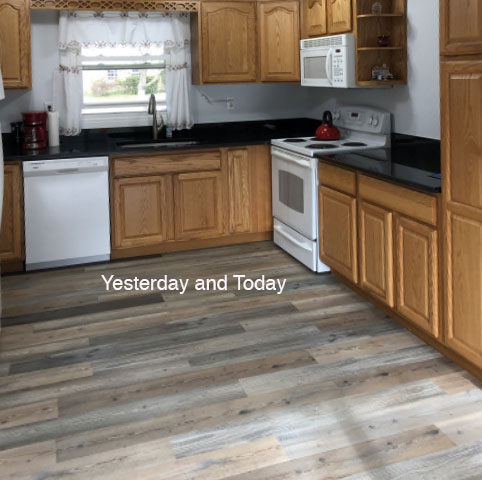

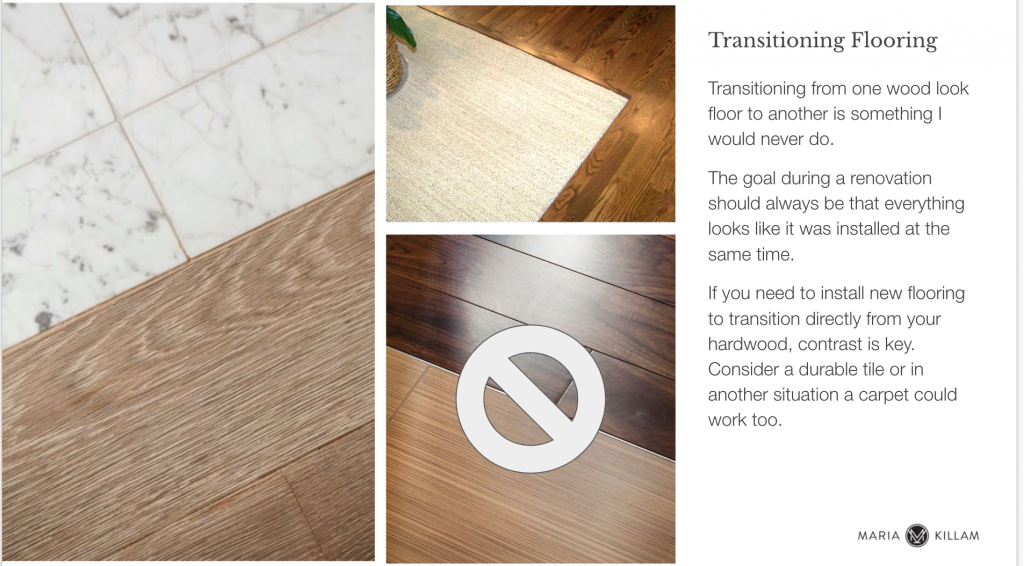
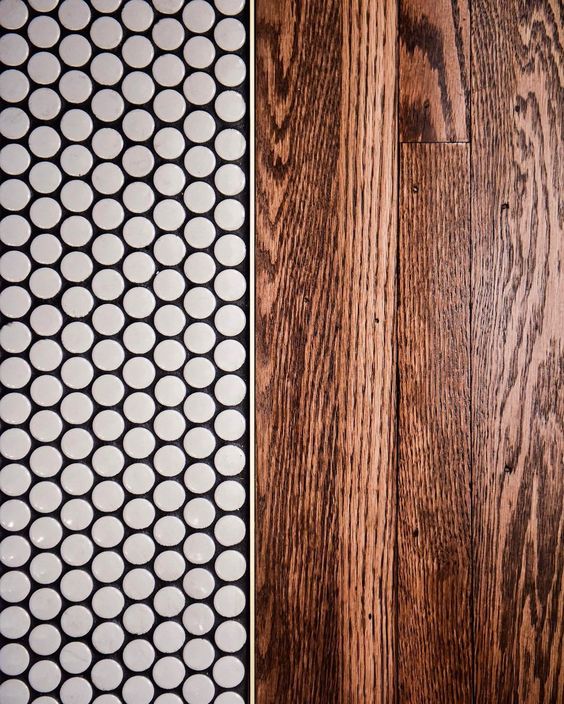

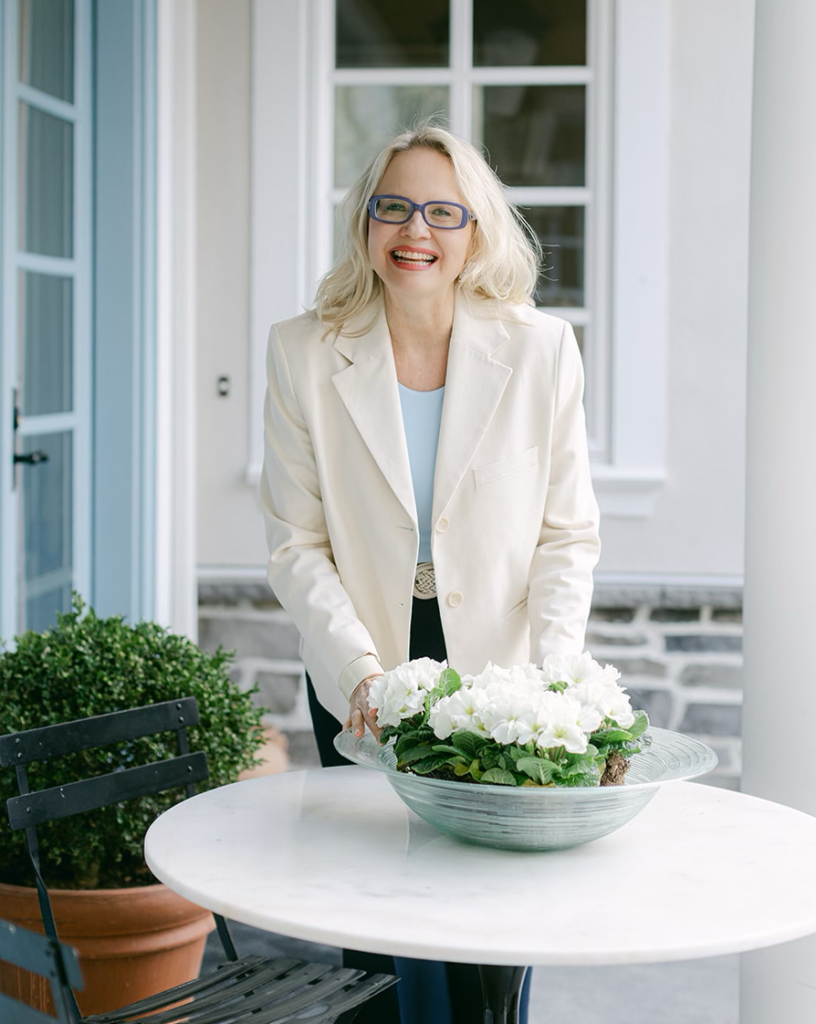



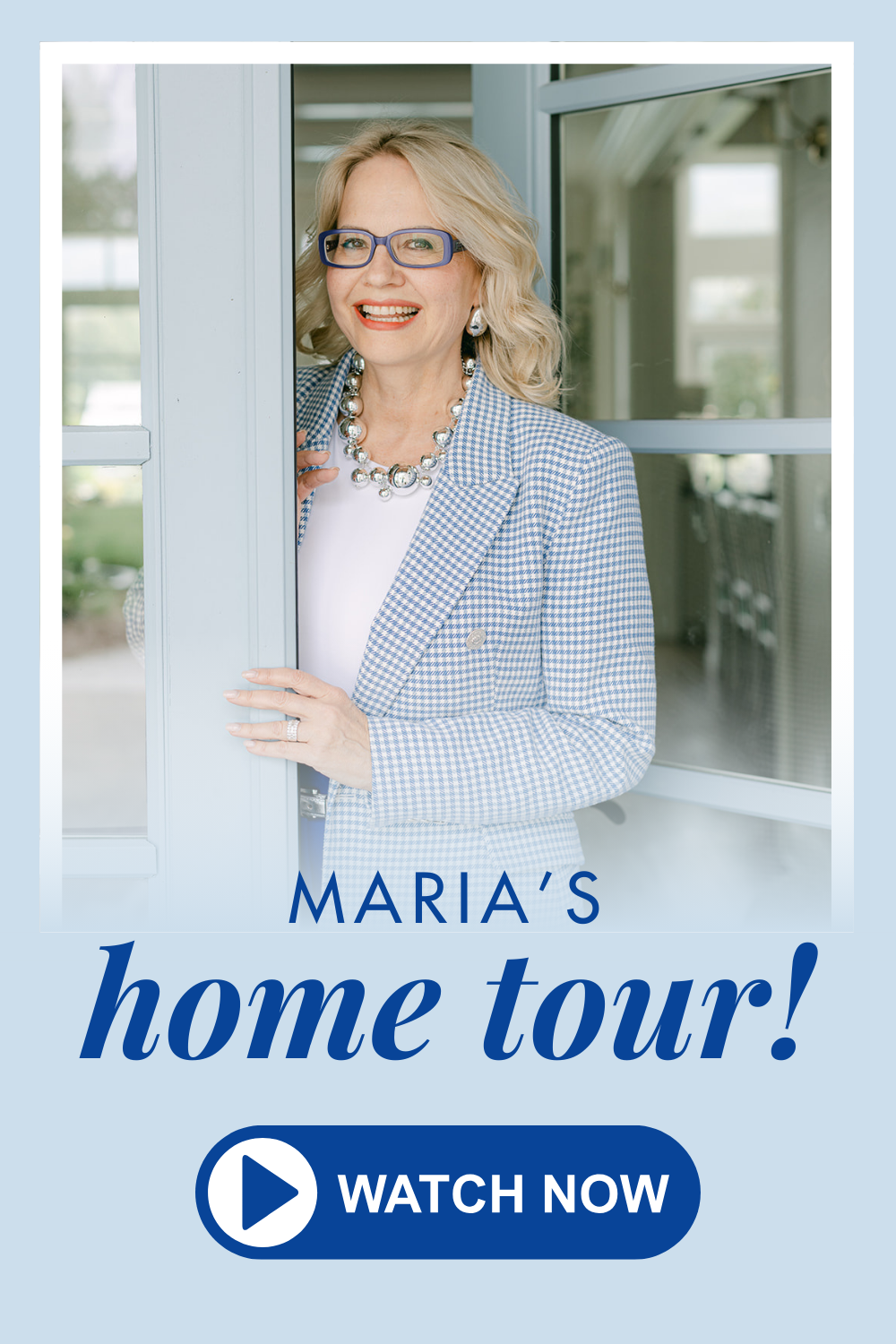
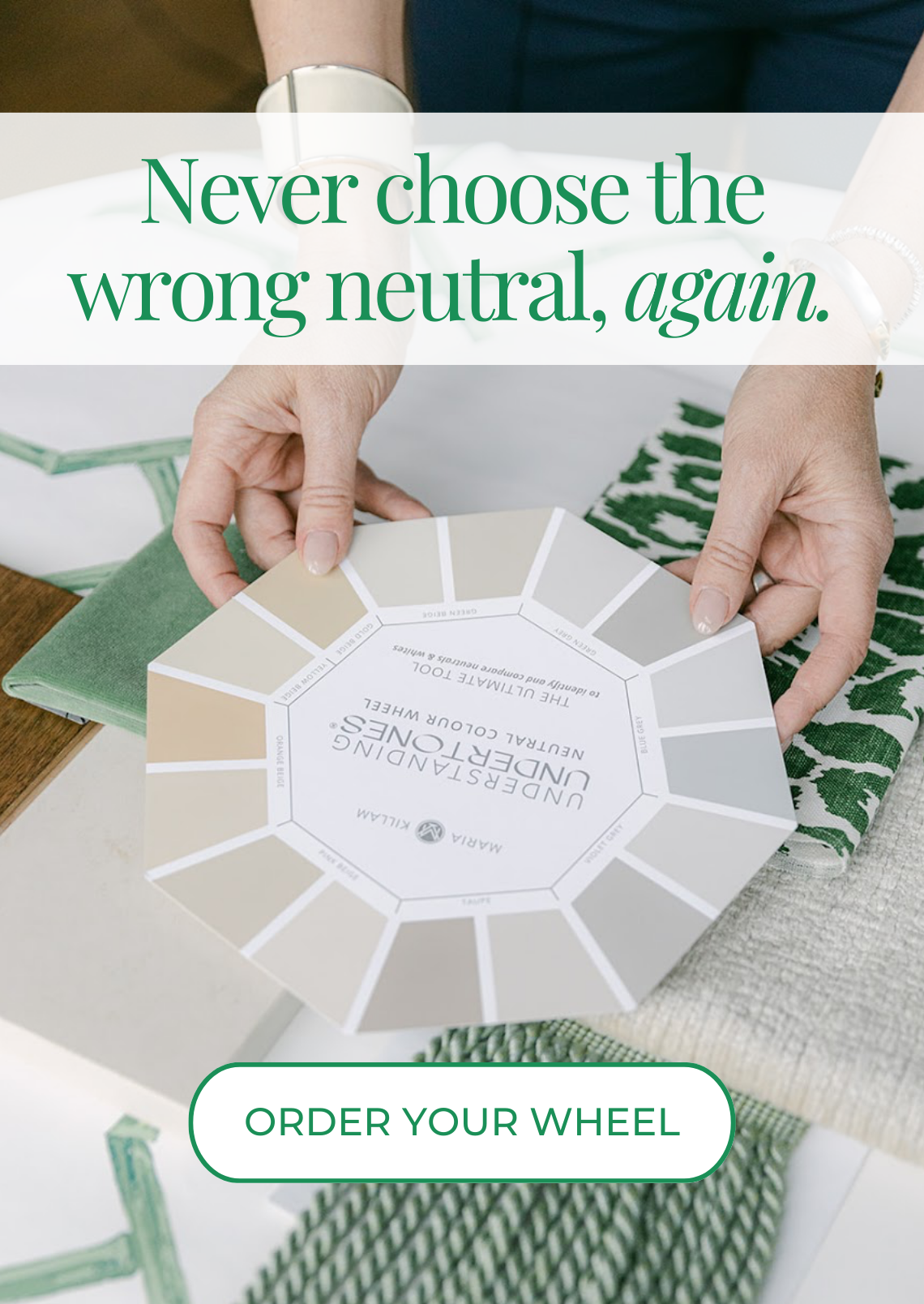

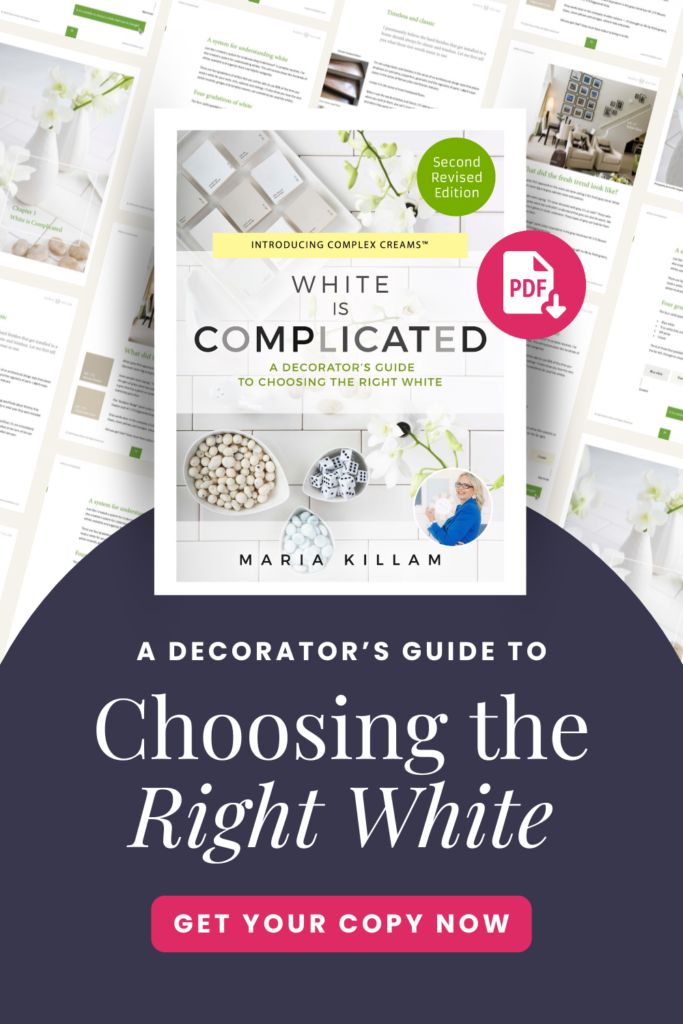








maria. You are sooooo spot on! If I could shout this from a mountain top I would! Nothing makes me more crazy than new trendy with timeless or older finishes! Well said!
Maria, I am a long time devoted fan, and I have learned so much from you.
My experience differs from one piece of your advice today. Faced with ugly and poorly installed tile in the foyer, kitchen, and powder room, we ripped it all up and replaced it with white oak hardwood, to match the rest of the first floor. My contractor sanded the existing hardwood, removed some pieces to “weave in” the old and new, left them unstained, and sealed them with several coats of poly. Weaving the boards costs more money, and you cannot do this with engineered hardwood, it must be the more expensive real-deal, but it was worth every penny. It looks like one continuous floor, not old and new. I have done this in two houses now, and in both places, everyone thinks it’s all original floor, but in a lighter, less orangy tone than usual in vintage houses.
Keep searching until you find the right contractor; the good ones know how to do this.
wow, that sounds gorgeous! You have an eye and experts to help. 🙂
Hi Valerie,
Sounds like a great solution. Would love to see a picture of what you did if you have one and can post it.
But it sounds like you simply extended the existing flooring into the other areas and then had the entire floor refinished. That’s not the concept of “old mixed with new” at all.
I think you may have misread what she was explaining. There was old in one area, then they added new in another area but “wove” them together in a seamless way. Sounds like a beautiful way to tackle this situation.
Thank you for sharing- great idea. Would love to see a photo.
Thanks for the great article! I have a hose full of orange red oak. I have seen a few articles where some have sanded them down, trying to remove the red/pink undertone, bleached and stained again to try to get it to look like white oak. Have you seen this done successfully?
Sand your red oak floors down and use Loba invisable or loba satin, red oak comes out looking like sand, as natural as if it had nothing on it. Love mine
We just did this and are so happy with the results!
C,
did the Loba invisible or Loba stain have any color to it or is it a clear coat? I have a client with red oak floors, they were sanded down and the hardwood contractor mixed a custom stain (she was trying to get a floor that looked like sand) but the pink of the red oak still comes through.
Loba is a clear stain. We used it on medium red cherry and it is honey coloured now. They did have to sand the floor twice. The first time a rosy tint was still visible in places.
See my comment below. Rubio Monocoat offers a large variety of colors. On our red oak, we used Castle Brown, which looks light-medium brown. I do not see red or pink.
You crack me up Maria..and I agree with you about that striped gray floor, SO bad! The hardest part of helping homeowners often times is talking them out of trendy finishes and into the classic/timeless.
This may be your funniest post lol. Yes, yes, yes! Agree, no homeowner should break these rules. It ruins your house because you can’t stop seeing it! I’ve been in many houses that need updating, but if they at least have a flow when you walk through, there’s comfort. When you start chopping up the space with different flooring, it’s like an “ouch” every time you run into it!
Rental properties often on tight time & $$$ budgets.
To be kind, 2nd pic, looks exactly like that scenario. With the flooring marked down an extra 60% off first sale price.
Only thing it’s missing? Snow white plastic mini-blinds!
Garden & Be Well, XO T
YES! And then when they decide to sell they will list it as “updated” and expect a premium because of that hideous floor and/or granite that looks like a lizard laying on top of cheap cabinets. House hunting can be so depressing . . .
House hunting is SO DEPRESSING. Totally agree. So much honey oak, with arch design, and vinyl plank out there. Heavy, heavy sigh.
Maria,
I’m a long time fan and blog follower and wanted to share some before and after pictures related to tile. My 1990 master bath has the obligatory huge jetted tub (which I use) but ugly linoleum that I wanted to replace with tile. I could not afford to get rid of the tub (again, I use it) but I brought home a zillion tiles trying to find something that would work with bossy (but fortunately not hideous)1990’s cultured marble. I remembered your advice, finally found a solid tile, ended up with new cabinets, hardware, shower door, but left all the cultured marble. I recently sold this house for over asking price and I know this bathroom and plain tile contributed to this. Thanks so much, Maria
Sorry, can’t figure out how to share pictures
I agree-When I had to replace the floor in my entry I wanted to match it to the wood floors in the rest of the house. Luckily the flooring contractor told me I shouldn’t try to match the other floor –it would never work. So I went with tile, I was not happy to use tile but I knew it was my only choice!. Getting great referrals is another reason to use a designer –they know which workman are good!!
Great post Maria, very helpful! Your posts are always full of practical and sound guidance.
Yes, flooring is definitely a big deal!! We decided to have our 3/4 inch cherry hardwood flooring sanded and lightened. To date, we have been out of our house for 3 weeks. It involves moving trucks and coordination with other trades, ie; plumbers and painters! The first sanding and coating did not take well in spots so the team came back and re-sanded and re-coated the whole floor (all our main floor living)! It’s definitely a big deal!! ….. but they look fantastic! The floors were a medium coloured cherry, to begin with, but now they look are a medium honey colour. Maria, you were my inspiration to get it done!
Thank for posting your response Lisa, I am curious, do they say how long will the lightening effect will last? I have 3/4″ cherry floors also and would love to lighten them. My floors were stained a darker brown color which I liked but, over time, the red of the cherry wood began to seep through and is really visible now. I don’t love the red, but I didn’t even know you could lighten it! Thank you!
Hi Erica, Cherry wood is a dilemma for sure because it is one of the most sun or light-sensitive woods on the market. We laid our cherrywood 20 years ago so it was quite a deep red/orange by this time and overdue for a sanding. I just couldn’t bring myself to remove it as an equal replacement on the market today is not the quality and definitely not 3/4 inch. We have been told by the hardwood sanding company that the new stains/clear coat used today are more resistant to discolouring and sun-sensitivity. That being said, I have done my own reading and have come to the conclusion that even though these new products are good there will still be discolouration/deeping of the colour over time with light and sun. Just not as much and it will take longer. To further help with this problem we are installing blinds on our large windows that we did not had blinds on before as we never needed them for privacy but realize now that it can lengthen the time of discolouration by using the blinds for the 2 hours a day of direct sun. It took 20 years to get to the red/orange that it was so we believe we could go another 15 to 20 years before another sanding. Hope this helps!
Erica, I don’t know how to post before and after photos here but if you feel comfortable providing your email I will send the photos to you.
This is a great post! I see you mention that flooring on the same level of the house should match. How about other levels of the house? We live in a split level and will be changing the hardwood floors on the main floor (you know my story!) of the house but can’t change the ones upstairs, at least not yet.
Great post! I see so many of the trendy finishes thrown on top of dated ones, and it just sticks out like a sore thumb and makes me crazy. Wonderful words of wisdom, and great insight. We’re in the process of planning a kitchen remodel, and as part of it, we will be tearing out horrible travertine tile and other mismatched floors, to install white oak flooring throughout. I swear, I’m as excited about this aspect of the project as I am about the kitchen remodel!
Hi Maria!
So glad I found you so many months ago. I have referenced your blogs along with your “white” and “undertone” books and color wheel often. I am not a designer but someone who likes my home look put together.
Onto my question…
We want to replace our bedroom rugs.
I live in a townhouse style condo. When we bought our home the whole downstairs has bamboo flooring ( not my favorite but I can live with it). We want to put hardwood in our bedrooms on the second floor. I don’t want bamboo but was hoping to use maple or oak similar color/tone as bamboo on first floor. The stairs are wood painted white. I am thinking since they are on two different floors I can make it work?
Here is where I hit a wall. There is a landing half way up on stairs and a small hallway on second floor connecting the bedrooms which have same bamboo flooring. If I put in wood floors in the bedrooms on second floor, how do I handle the hallway and landing?
Or would the simplest and most cohesive choice would be to replace bedroom rugs with new bedroom rugs?
Or should I just do bamboo also in the bedrooms?
I love hardwood floors bur love cohesiveness more.
Thank you
Bernadine
If I understand the rules correctly, it’s all the exact same bamboo flooring (part of the hardwood family) or something completely different like carpet. But not maple/oak to bamboo, unless you plan to replace the bamboo with the same new hardwood later. If you really want maple/oak in the bedrooms upstairs, then the hall must be the same and I would paint the landing white.
Yes yes yes!! You are bossy and nice and 1000% correct. I wish all my friends who are renovating would understand this. High budget and low, I have seen so many people make mistakes with this and end up with choppy, awkward, ill conceived things happening with the floors.
It looks like you forgot to credit the image you used from Yellow Brick Home.
I was just about to post the same thing! 🙂
We bought a house built over the years of 1945-1947 as the owner/builder had time & money. The radiators are of various designs and other things you can tell were done depending on what was available at the time.
Before we moved in, we pulled up the carpet since we could see there were oak hardwood floors under it in the living room & dining room. In the bedrooms, there were wood floors but they were a different wood, Douglas fir (?). We didn’t want to replace the bedroom floors as we weren’t sure what remodeling we’d be doing in the future. We had all of the floors sanded and stained to as close to the same color as the contractor could get. I think he used different stain colors on the different woods so he could get both floors close to the same color. The floor boards are also different widths. The floors only meet in the transition from the living room to the bedroom hallway which is about 3 feet wide, where the horizonal living room floor meets the vertical hallway floor.
Way happier with wood floors than the old, smelly wall to wall carpet. But it served a good purpose, keeping the wood floors safe!
I just have to say…I LOVE this post. It’s succinct and so helpful in explaining this whole flooring thing! I wish the world of contractors, builders, designers, and flooring stores could get this in their heads so everyone and every house could become more beautiful and flowing! That’s what I wish!! Can you get on all the news and personal interest programs and just give this one priceless piece of wisdom! You’d instantly get millions of new followers! And save the world so much money and headache all while beautifying everyone’s personal space! It would help people’s mental health too! Especially those of us who are what is referred to as an HSP! (Highly sensitive person) 🙂
Hi Norma! Fellow HSP here! So true about the mental health aspect to our home design…great comment! 👋
Thanks for the great article. It is very timely for me as due to a leak I am having to get new kitchen flooring installed and the flooring specialist is coming today.
That darn muddy gray/brown plank floor? Why are we still seeing so much of this??? Why????
I know exactly why.
Around 2016 is smack dab in the middle of the ‘gray’ trend. Production factories have geared up and mass production is in full swing mid-decade. The consumer showrooms are FULL of it, plus it’s on PO (purchase order) for a few more yearly quarter buying seasons. So think maybe 2-3 more years to meet demand. Now the knowing folks behind the scenes in the design and purchasing department are already seeing the trend shift by 2018 to a different product, but of course they can’t back out of money already spent on the PO and it takes factories a while to change production runs. What happens next? Well, the trend is dying a slow death, but there’s still a LARGE amount of product to move. This shows up as considerable discounts to the end-buyer. Because selling at a loss is better than not selling at all, your average contractor/house flipper/hapless consumer walks into any home improvement store and sees 50 shades of gray/brown plank on deep discount STILL going on in 2021 to move that inventory, thus ending with that terrible “yesterday and today” combo. This is typically a mid-range and lower priced home problem, but I like to browse homes for sale in the Santa Barbara, CA area, and I’ve seen it in million dollar homes too.
When we were renovating our house in 2013, we had worn red oak hardwood floors throughout, except for bedroom and kitchen. After consulting with you, Maria, we went with matching red oak in every room except the tiled bathroom, interweaving it with the existing hardwood. Then we finished the floors using European hard oil, Rubio Monocoat. Because this finish allows you to complete adjacent areas at different times without any visible joining, we could have the kitchen done, then the dining room, then the new living room, with the hallway worked in somewhere. Each of these areas is contiguous with at least one other, yet the floor looks like it was installed and finished at the same time. This piecemeal approach was crucial in our small house, allowing us to stay in the house and only move furniture from room to room instead of out of the house. We could not have done it had we used any of the common hardwood finishes.
Oops! Except for BATHROOM and kitchen!
This is my plan too! We can stain and wax the floors one area at a time OURSELVES! And I get away from polyurethane! My only problem is sanding all the floors. I might even use Rubio Monocoat on my oak 6-panel doors too instead of painting them. I just discovered a sanding glove called Sandi Hands that I think will allow me to more easily sand the door crevices. I really don’t understand why Rubio Monocoat isn’t widely known or used.
My 1985-buld very traditional Virginia townhouse had oak floors and staircase on the main floor, except for dated ugly vinyl in the kitchen and powder room. The oak had the strong golden color, but that works with the colors I decorate with. The upstairs bedrooms and hall were carpeted, with vinyl in two bathrooms. Downstairs/basement was carpeted – “seafoam green,” dated, old, and ugly; the stairs to the basement were also carpeted – eww.
My solution took several years to implement, but I loved the finished product.
-The basement and basement stairs carpeting was ripped up. Cork click planks were installed. The basement stairs were just pine, which I painted. So much easier to keep clean.
-The kitchen and powder room on the main floor got gluedown cork tile – better for rooms with water sources; I purchased enough to do the upstairs bath flooring as well.
-The upstairs hall and one of the bedrooms had the click plank cork flooring installed. The finish on the glue down tiles and click planks was the same. The bathroom floors got the glue-down cork tile.
The townhouse now felt seamless, as the cork had the same coloring as the existing oak floors. I kept the newer carpeting in the two bedrooms upstairs, which looked much better after a steam cleaning. It took four years, but was totally worth it. Another original finish I was not tempted to mess with was the black slate slab surround and hearth on the fireplace. Timeless!
Great, timely article! We’ve got the narrow, honey colored oak in living areas, and need to replace old vinyl flooring in the kitchen and adjacent powder room…and I’ve put it off because I wasn’t sure what to do.
The sisal rug image is actually from the blog Yellow Brick Home.
Great post!
HA! My instagram comment made your blog post, Maria! I am so honoured! And I am happy to see that you were able to find an image that PRECISELY illustrates my point! This post made my day!
Great advice, once again.
Thank you for the additonal information about transitioning flooring by using another timeless product instead of competing with or trying to match existing flooring. I made mistakes along the way-never to be repeated again! 😉
I am trying to bring my 90’s house up-to-date on a conservative budget for resale when I have to downsize, possibly in the near future because of my age and being a widow. My master bath is fairly large so materials will be expensive. I am trying to work with what I have as a beginning, including blue walls. I had my 9 foot honey oak vanity painted a soft grey. that matches the existing grey grout in white tile with a subtle hint of grey veining. I want to make my cultured marble shower into marble look large porcelain tile. Toilet, tub and 2 drop sinks are white. The problem is replacing my counter top. I want quartz but do I opt for solid white or for a subtle marble effect like the shower? Or a variegated grey? Is a white counter going to be hard to match with my white sinks? I am trying for classy, not trendy.
Maria, I am so glad I found you. We are building & I am following your advice for combining permanent elements (flooring, cabs, counters, tile) to a tee! So far I have a beautiful, classic look going! Thank you!
Maria,
As a real estate agent I almost choked on my coffee when you said NO to the weathered grey LVP! Every badly done flip in my area has that horrendous floor in it, and buyers go wild for it. You are so right; it is not timeless. I read my husband your blog as he is tired of hearing me rant and rave about those floors. It really is time for those to go away. Thank you for the laugh. Love your blog!
Maria, I think you could make a fortune with a book on timeless flooring style. Choosing a timeless LVP for most of the house has me ready to gouge out my eyeballs, but choosing a timeless tile/grout color combo and then successfully transitioning that to LVP? I completely understand how bad flooring decisions happen in the first place. If I’ve learned anything from your site, it’s that of all the racks of stuff on offer at the flooring store, I should probably only really be considering 5 of them. If only I knew which 5 🙂
Came across your post and loved it. I couldn’t shred more about transitions. Question on wood floors and pets. I have 20 yr old tile throughout my whole downstairs and has stayed clean and easy for pet accidents. Ha the only thing giving its age away is the darn grout line size. Back then it was much wider! Do you ever put in stone or tile floors today that look elegant (transitional) if wood isn’t the best option for pets.